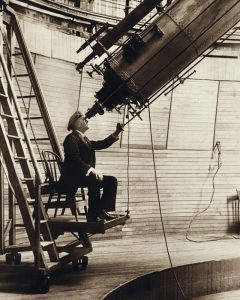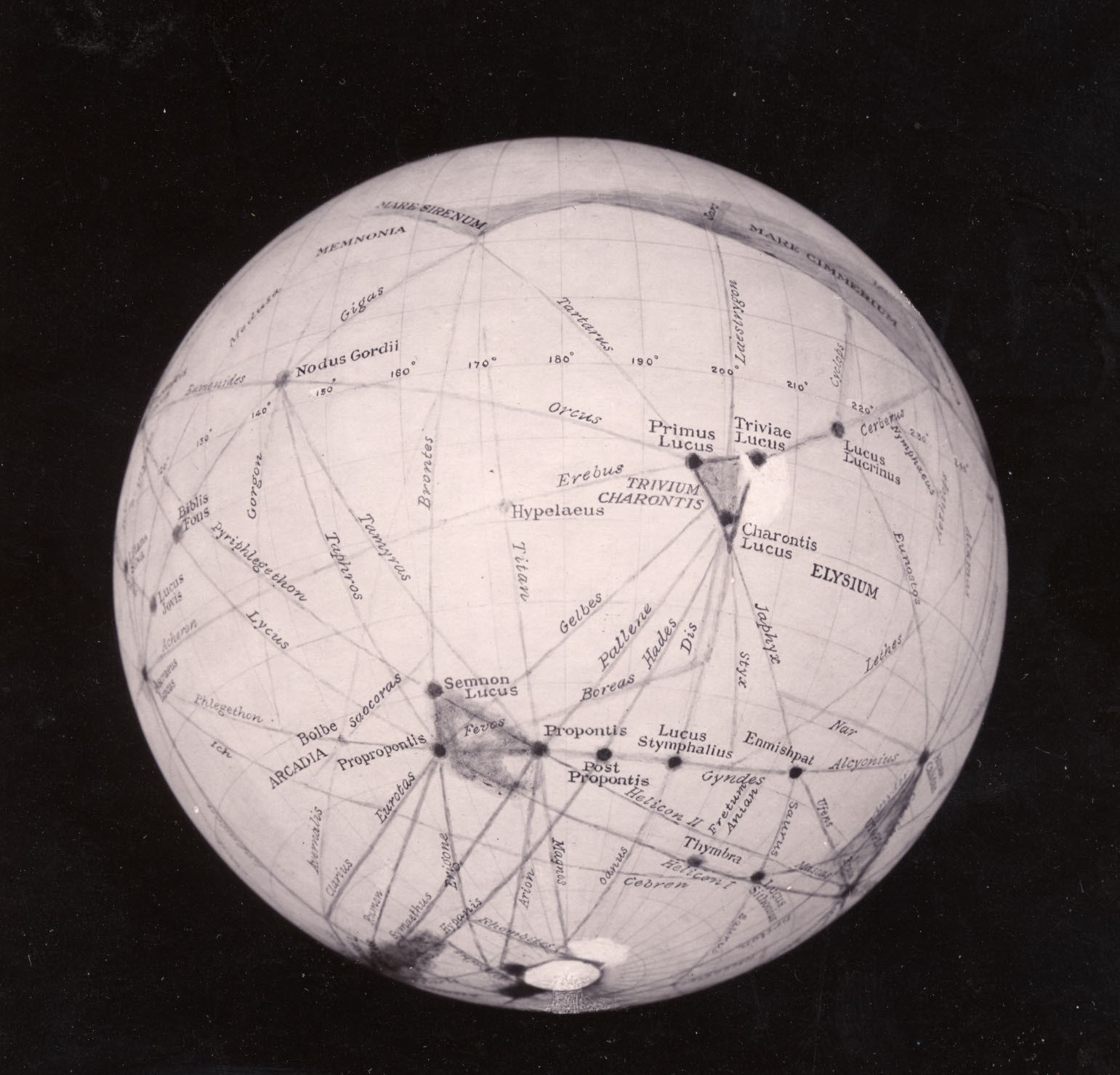
Percival Lowell created a Mars globe at each opposition from 1894 to 1916, twelve total. They're hand-drawn and remarkably detailed. | Lowell Observatory
Percival Lowell’s Search for Life on Mars
A Quest Begins

Percival Lowell observing at the Clark Telescope | Lowell Observatory Archives
In the 1890s, Lowell Observatory founder Percival Lowell became inspired by Italian astronomer Giovanni Schiaparelli’s 1877 description of canali, or channels, on the surface of Mars. As a result, he decided to devote his fortune and energy to the study of Mars and the possibility of life on its surface.
Lowell began seeking a clear-sky location for an observatory in the late 19th century, sending his assistant Andrew Douglass to Arizona in February 1894 to find a suitable site. Douglass evaluated several locations and found that Flagstaff had consistently good weather for observations. Based on this, Lowell chose a mesa near Flagstaff, which would become known as Mars Hill, and began preparations.
Lowell himself arrived in Flagstaff in May of 1894 and began observations of Mars using two borrowed telescopes: an 18-inch from lensmaker John Brashear, and a 12-inch from a colleague’s brother at Harvard University. In the following year, he began making arrangements with the Alvan Clark & Sons firm to build a 24-inch refracting telescope—the most powerful of its kind at the time—for use in his studies.
Lowell’s Research
Lowell’s tireless study of Mars’s surface resulted in an incredibly detailed body of work, including sketches, observation logs, hand-drawn globes, and eventually, photographs. Every rendering of Mars he created featured the infamous canals criss-crossing its surface, with little variation in their structure to be seen over time. These, he claimed, were compelling evidence of intelligent life on the planet. He compared them to the checkerboard patterns of man-made grainfields on Earth, pointing to their “hopeless lack of irregularity” as evidence that they weren’t formed naturally.

Original black and white drawing of Mars by Percival Lowell. Shows canals, polar cap and other surface features as seen by Lowell. | Lowell Observatory Archives
He reported that many of the canals he’d studied and drawn were identical to those charted by Schiaparelli, further supporting his belief in the astronomer’s findings. However, while Shiaparelli believed the canals to be of a natural, geological origin, Lowell was firm in the belief that they were artificial. According to William Graves Hoyt (1976, p. 81): “There were three major reasons to “negate the idea of natural causation of the lines,” he declared: (1) their straightness, (2) their uniform width, and (3) the discovery of their systematic radiation from special points—the small, round, dark spots that [William] Pickering had considered “lakes” in 1892 but which Lowell had preferred to call “oases” for the purposes of this theory.”
Lowell believed that the canals being artificial provided the best evidence that the inhabitants of Mars were intelligent, perhaps even more intelligent than those of Earth. “Quite possibly such Martian folk are possessed of inventions of which we have not dreamed,” he wrote in an article for Nature in 1907, “and with them electrophones and kinetoscopes are things of a bygone past, preserved with veneration in museums as relics of the clumsy contrivances of the simple childhood of the race. Certainly we see hints at the existence of beings who are in advance of, not behind us, in the journey of life” (Hoyt, 1976, p. 85).
Public Reactions
As Lowell earnestly shared his findings with the astronomical community and the public at large, what had previously been a polite, formal debate among astronomers became a raging public controversy. While most of the scientific community was skeptical of Lowell’s claims, the idea of life on other planets captured the minds of the public. Thousands of people outside of the astronomical community learned about Lowell’s theories from his magazine articles, his lectures, or his book Mars, published in 1985. Even more people absorbed his claims from secondhand, often unreliable sources. The press at the time was already well-versed in the idea of sensationalized news, and they often shared Lowell’s research in oversimplified terms.
Lowell published his Mars theories in three books: Mars (1895), Mars and Its Canals (1906), and Mars As the Abode of Life (1908). Lowell wrote with a dramatic flair that kept the layperson engaged, adding in his personal reflections on life and science, as well as jokes and puns at the expense of his critics in the scientific community (Hoyt, 1976, p. 71). In this way, he made astronomy accessible to the public in a way that it hadn’t been previously.
References
- Hoyt, William Graves. Lowell and Mars. University of Arizona Press, 1996.
- Britannica, The Editors of Encyclopaedia. “A. Lawrence Lowell”. Encyclopedia Britannica, 22 Mar. 2024, https://www.britannica.com/biography/A-Lawrence-Lowell. Accessed 1 August 2024.